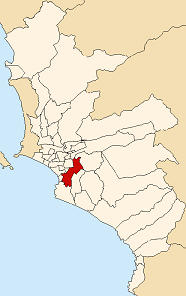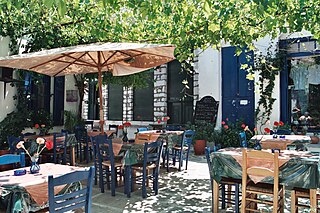Santiago Queirolo (originally named Giacomo), was a Peruvian pisco producer based in Pueblo Libre, a district in Lima.[ citation needed ]
Santiago Queirolo (originally named Giacomo), was a Peruvian pisco producer based in Pueblo Libre, a district in Lima.[ citation needed ]
Italian immigrant Santiago Queirolo Raggio arrived in Peru in the 1880s, joining a thriving Italian community that had been developing for years in the city of Lima. Living in Pueblo Libre, then still little more than an agricultural town on the edge of Lima, he sold octopus and other sea food on the street before founding his tavern, Antigua Taberna Queirolo. Here he sold traditional Peruvian Creole food and bottles of wine and Pisco from grapes grown on land he bought around Cañete, south of the city.[ citation needed ]
Eventually his Pisco outsold his lunches, with Santiago Queirolo becoming a brand name for wines and spirits while the restaurant became only a side business.[ citation needed ] Although the Antigua Taberna Queirolo is still in business, it's the Santiago Queirolo warehouse that sees most business. Here, where cases of Pisco are piled you will see restaurateurs and wholesalers placing large orders.[ citation needed ] Today you can find Santiago Queirolo wines and spirits in many supermarket or restaurants around the world.[ citation needed ]

Brandy is a liquor produced by distilling wine. Brandy generally contains 35–60% alcohol by volume and is typically consumed as an after-dinner digestif. Some brandies are aged in wooden casks. Others are coloured with caramel colouring to imitate the effect of aging, and some are produced using a combination of both aging and colouring. Varieties of wine brandy can be found across the winemaking world. Among the most renowned are Cognac and Armagnac from southwestern France.

Lima, originally founded as Ciudad de Los Reyes is the capital and the largest city of Peru. It is located in the valleys of the Chillón, Rímac and Lurín Rivers, in the desert zone of the central coastal part of the country, overlooking the Pacific Ocean. Together with the seaside city of Callao, it forms a contiguous urban area known as the Lima Metropolitan Area. With a population of more than 9.7 million in its urban area and more than 10.7 million in its metropolitan area, Lima is one of the largest cities in the Americas.
Pisco is a colorless or yellowish-to-amber colored brandy produced in winemaking regions of Peru and Chile. Made by distilling fermented grape juice into a high-proof spirit, it was developed by 16th-century Spanish settlers as an alternative to orujo, a pomace brandy that was being imported from Spain. It had the advantages of being produced from abundant domestically grown fruit and reducing the volume of alcoholic beverages transported to remote locations.

A sommelier, or wine steward, is a trained and knowledgeable wine professional, normally working in fine restaurants, who specializes in all aspects of wine service as well as wine and food pairing. The role of the wine steward in fine dining today is much more specialized and informed than that of a "wine waiter". Sommeliers Australia states that the role is strategically on par with that of the chef de cuisine.

Pisco is a city located in the Department of Ica of Peru, the capital of the Pisco Province. The city is around 9 metres above sea level. Pisco was founded in 1640, close to the indigenous emplacement of the same name. Pisco originally prospered because of its nearby vineyards and became noted for its grape brandy or pisco which was exported from its port. Pisco has an estimated population of 104,656.

New World wines are those wines produced outside the traditional winegrowing areas of Europe and the Middle East, in particular from Argentina, Australia, Canada, Chile, Mexico, New Zealand, South Africa and the United States. The phrase connotes a distinction between these "New World" wines and those wines produced in "Old World" countries with a long-established history of wine production, essentially in Europe, most notably: France, Italy, Germany, Spain and Portugal.

A pisco sour is an alcoholic cocktail of Peruvian origin that is typical of Peruvian cuisine. The drink's name comes from pisco, which is its base liquor, and the cocktail term sour, about sour citrus juice and sweetener components. The Peruvian pisco sour uses Peruvian pisco as the base liquor and adds freshly squeezed lemon juice, simple syrup, ice, egg white, and Angostura bitters. The Chilean version is similar, but uses Chilean pisco and Pica lime, and excludes the bitters and egg white. Other variants of the cocktail include those created with fruits like pineapple or plants such as coca leaves.

Santiago de Surco, commonly known simply as Surco, is a district of Lima, Peru. It is bordered on the north with the district of Ate Vitarte and La Molina; on the east with San Juan de Miraflores, on the west with San Borja, Surquillo, Miraflores and Barranco, and on the south with Chorrillos.
Peruvian cuisine reflects local practices and ingredients including influences mainly from the indigenous population, including the Inca, and cuisines brought by immigrants from Europe ; Asia ; and Africa. Without the familiar ingredients from their home countries, immigrants modified their traditional cuisines by using ingredients available in Peru.

A taverna is a small Greek restaurant that serves Greek cuisine. The taverna is an integral part of Greek culture and has become familiar to people from other countries who visit Greece, as well as through the establishment of tavernes in countries such as the United States and Australia by expatriate Greeks.

Pueblo Libre is a district of the Lima Province in Peru. Its name, which means Free Town or Free People, was granted by José de San Martín on April 10, 1822, as a recognition of the patriotism shown by its inhabitants during the Peruvian War of Independence. The district was created by law 9162 on November 5, 1940. Pueblo Libre is a middle-class residential community and has the most parks in Lima, although it has several branches of banks, local private universities and major corporations.
Alpana Singh is an American Master Sommelier, restaurateur and local television personality in Chicago, Illinois.

Chifa is culinary tradition based on Chinese Cantonese elements fused with traditional Peruvian ingredients and traditions. Though originating in Peru, the Chifa tradition has spread to neighboring countries like Ecuador, Chile and Bolivia. Chinese immigrants came to Peru mainly from the southern province of Guangdong and particularly its capital city Guangzhou in the late 19th and early 20th centuries. They settled for the most part in the coast of Peru and the capital city of Lima. The term chifa is also used to describe a restaurant where this type of food is served. Chinese-Peruvian food has become one of the most popular types of food in Peru. The first Chinese–Peruvian fusion restaurants were opened in Lima in around 1920 in Lima's China town ; there are thousands of Chifa restaurants across all districts of Lima and many more throughout other cities of Peru, with sometimes multiple independent restaurants operating in close proximity on a single city block.
Johnny Schuler is an author, chef and restaurateur, distiller and television personality from Lima, Peru. He owns two restaurants in Lima, Key Club and La Granja Azul. Schuler is an authority on pisco, a spirit that has been declared as a national cultural heritage by Peru's National Institute of Culture.
Virgilio Martínez Véliz is a Peruvian chef and restaurateur. He is considered one of the new generation of Peruvian chefs promoting the spread of Peruvian cuisine. He is known for his use of applying modern cooking techniques to indigenous Peruvian ingredients. Marie Claire magazine has called him "the new star of Lima's gastro sky." On April 29, 2013, his flagship restaurant, Central, entered as number 50 in The World's 50 Best Restaurants as awarded by the British magazine Restaurant. In 2014, Central jumped 35 places to number 15, winning the "Highest Climber" award, and later that year was named Best Restaurant in Latin America.
Pedro Manuel Venturo Zapata was an entrepreneur, engineer, agronomist, paso horse breeder, vintner and Minister of Agriculture. He was the CEO of Hacienda Higuereta y Anexos - Negociacion Vinicola Pedro Venturo S.A. from 1925 to 1952.
Pedro Manuel Venturo Zapata was the CEO of "Hacienda Higuereta y Anexos - Negociacion Vinicola Pedro Venturo S.A." from 1925 to 1952.
Teresa Izquierdo was a noted Peruvian master chef. Affectionately known as "the mother of Peruvian food", she founded the renowned restaurant El Rincón Que No Conoces, in a working-class neighbourhood of Lima, receiving acclaim within and outside of the country as one of the chief proponents of traditional coastal criollo cuisine. Characteristically humble, she insisted in interviews on being called a cook rather than a chef. A contest for the top soup-kitchen chefs is named after her.
A sanguchería, in Peruvian cuisine, is a kind of restaurant specializing in sandwiches, juice, sodas, and occasionally alcoholic beverages. Peruvians customarily relate these establishments to the night life, as a way to satisfy one's hunger after a night on the town.

The Lima campaign is the third land campaign of the War of the Pacific, carried out by Chile between December 1880 and January 1881. The campaign ended with the Chilean occupation of the Peruvian capital and the establishment of the Chilean authority in it and other surrounding territories, which would extend until 1883, with the end of the war.